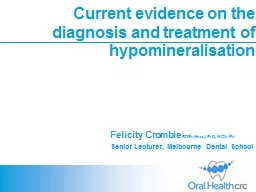

Felicity Crombie BDSc Hons PhD M Clin Ed Senior Lecturer Melbourne Dental School Hypomineralisation What can go wrong before the teeth erupt What does it mean once the teeth have erupted ID: 931288
Download Presentation The PPT/PDF document "Current evidence on the diagnosis and tr..." is the property of its rightful owner. Permission is granted to download and print the materials on this web site for personal, non-commercial use only, and to display it on your personal computer provided you do not modify the materials and that you retain all copyright notices contained in the materials. By downloading content from our website, you accept the terms of this agreement.
Slide1
Current evidence on the diagnosis and treatment of hypomineralisation
Felicity Crombie
BDSc (Hons), PhD
,
M
Clin
Ed
Senior Lecturer, Melbourne Dental School
Slide2Hypomineralisation
What can go wrong before the
teeth erupt?
What does it mean once the teeth have erupted?
Slide3Hypomineralisation
Slide4Hypomineralisation
What can go wrong before the
teeth erupt?
Early childhood
Birth to 8 years old (United Nations)
Primary & permanent dentition relevant
~13 weeks in utero to ~ 4-5 years of age
Slide5Hypomineralisation
What can go wrong before the
teeth erupt?
Hypoplasia
Quantity of
tissue
Hypo-mineralisation/calcification
Quality of tissue
Other
Slide6Amelogenesis
Imperfecta
All
teeth affected
primary
and permanent dentition
Variety of phenotypes
enamel
hypomineralised
,
hypoplastic
or both
Non-enamel
abnormalitiesPrevalence 1:700- 1:14000Aetiology genetic
Slide7Amelogenesis
Imperfecta
Gene
Protein and/or Description/Role
AMELX
Amelogenin
: Enamel matrix protein
ENAM
Enamelin
: Enamel
matrix protein
WDR72
Intracellular protein
- ? vesicle turnoverFAM83H
Intracellular
protein - ? keratin interaction
MMP20
Matrix metalloproteinase 20: secretory stage enamel matrix removalKLK4Kalikrien 4: maturation stage enamel matrix removalC4ORF26Extracellular phosphoprotein capable of promoting mineral nucleationDLX3Transcription factorLAMB3Cell attachmentSLC24A4Calcium transporter
Adapted from Wright
Slide8Dentinogenesis
Imperfecta
and
Dentine Dysplasia
All teeth
affected
primary
and permanent
dentition
often more severe in
primary
dentition
Discoloured
, bulbous crownsShort roots
Pulpal obliteration
Aetiology genetic
Slide9Fluorosis
Hypomineralisation
increased fluoridated apatite?
Hypoplasia and post-eruptive breakdown (PEB)
Primary dentition?
Prevalence highly variable
Australia ~35% individual, ~40% tooth level
mostly very mild or mild
Aetiology predominantly environmental
Richards et al, 1992
Do, 2007
Arrow, 2008
Slide10Molar
Incisor
Hypomineralisation
(MIH)
“hypomineralisation of systemic origin of one to four permanent first molars, frequently associated with affected incisors”
Weerheijm
, 2001
Slide11MIH
Crombie et al, 2008
Slide12MIH
Hypomineralisation
+/- PEB of key teeth
permanent dentition only (?)
Crombie et al, 2013
Fearne
et al, 2004
Mahoney et al, 2004
Slide13MIH
Hypomineralisation +/- PEB of key teeth
permanent dentition only (?)
higher carbonated apatite content
Crombie et al, 2013
X
ie
et al, 2008
Taube et al, 2015
Fraser et al, 2014
Slide14MIH
Hypomineralisation +/- PEB of key teeth
permanent dentition only (?)
higher carbonated apatite content
increased protein
content
surface layer
Crombie et al, 2013
Mangum et al, 2010
Farah et al, 2010
Melin
et al, 2015
Slide15MIH
Hypomineralisation +/- PEB of key teeth
Highly variable
Photos courtesy of Karin
Weerheijm
Slide16MIH
Hypomineralisation +/- PEB of key teeth
Highly variable
Non-enamel abnormalities
dentine
Fagrell
et al, 2008
Cocker, DCD thesis, 2014
Heijs
, 2007
Slide17MIH
Hypomineralisation +/- PEB of key teeth
Highly variable
Non-enamel abnormalities
dentine
pulp
Rodd, 2007
Fagrell
et al, 2008
Slide18MIH
Hypomineralisation +/- PEB of key teeth
Highly variable
Non-enamel
abnormalities
Prevalence
Australia ~22%; 6% “severe”
Aetiology
uncertain
environmental + epi/genetic?
Arrow, 2008
Crombie et al, 2009
Alaluusua
, 2010
Jeremias et al, 2013
Kuhnisch
et al, 2013
Slide19MIH
Expand definition?
Second Primary Molars especially
Other primary and permanent teeth
Hypomineralised
Second Primary Molars (HSPM)
Australian prevalence 14%
may be associated with MIH in permanent dentition
similar problems – similar properties?
Owen, DCD Thesis, 2015
Leen
, DCD Thesis, 2015
Ghamin
et al, 2013
Elfrink
et al, 2012
Mittal & Sharma, 2013
Costa-Silva et al, 2013Negre-Barber et al, 2016
Slide20Hypomineralisation
What does it mean once the teeth have erupted?
Slide21Amelogenesis
Imperfecta,
Dentinogenesis Imperfecta
& Dentine Dysplasia
Diagnosis
all teeth
family history
genetic investigation
other associated conditions e.g.
osteogenesis
imperfecta
Treatment
generally specialistcomplex and lifelonginfluenced by type
Slide22Fluorosis
Diagnosis
primary teeth spared
fluoride history
other diagnoses not mutually exclusive
Photo courtesy of David Manton
Slide23Fluorosis
Treatment
primary prevention may be possible
generally aesthetic
etching properties
Photos courtesy of Fiona Ng and David Manton
Slide24Fluorosis
Treatment
primary prevention may be possible
generally aesthetic
etching properties
Al-
Sugaur
&
Akpata
1999
Torres-Gallegos et al 2012
Slide25MIH
& HSPM?
Diagnosis
key teeth
non-chronological
deterioration can be rapid
be alert for atypical observations
hypoplasia versus PEB
Fragelli
et al, 2015
Ghanim
et al, 2015
Chawla et al, 2008
Slide26MIH
& HSPM?
Treatment
“Re”-mineralisation
Crombie et al 2013
Baroni
& Marchionni, 2011
Slide27MIH
& HSPM?
Treatment
“Re”-
mineralisation
Restorative issues
Intervention MIH group Control group
Sealants 35 (25.7%) 90 (69.2%)
Amalgam fillings 18 (13.2%) 6 (4.6%)
Composite resin 59 (43.4%) 34 (26.2%)
SSCs 24 (17.6%) - Restorative intervention 101 40
(74.3%) (30.8%)
Total interventions
136 130Mejare et al 2005Kotsanos et al 2005Jalevik & Klingberg 2002
Slide28MIH
& HSPM?
Treatment
“Re”-
mineralisation
Restorative issues
etch
William et al 2006
Slide29MIH
& HSPM?
Treatment
“Re”-
mineralisation
Restorative issues
etch
pre-treatment
recommendations
Burrow conference presentation
Slide30MIH
& HSPM?
Treatment
“Re”-
mineralisation
Restorative issues
etch
pre-treatment
recommendations
full coverage
Pictures courtesy of Marilyn Owen
AAPD website
Lygidakis
, 2009
Sood
et al, 2008
William et al, 2006
Chay et al, 2014
Ghandi et al, 2012
Zagdwon
et al, 2003
Slide31Treatment
“Re”-
mineralisation
Restorative issues
etch
pre-treatment
recommendations
full coverage
Extraction
orthodontic considerations
8.8 years
10.2 years
13.8 years
MIH
& HSPM?
7.7 years
Jalevik
&
Moller
, 2007
Mejare
et al 2005
Slide32Treatment
“Re”-
mineralisation
Restorative issues
etch
pre-treatment
recommendations
full coverage
Extraction
orthodontic considerations
Anaesthetic
Local
General
MIH
& HSPM?
Cabasse
et al 2015
Eidelman et al 2000Ridell et al 2015Jalevik & Klingberg 2002 and 2012
Slide33Anterior lesions
caries and PEB relatively rare
aesthetics
MIH
& HSPM?
Mastroberardino
2012
Rodd et al, 2011
Slide34Anterior lesions
caries and PEB relatively rare
aesthetics
MIH
& HSPM?
Natarajan et al 2015
Crombie et al 2014
Attal et al 2014
Slide35Thank you